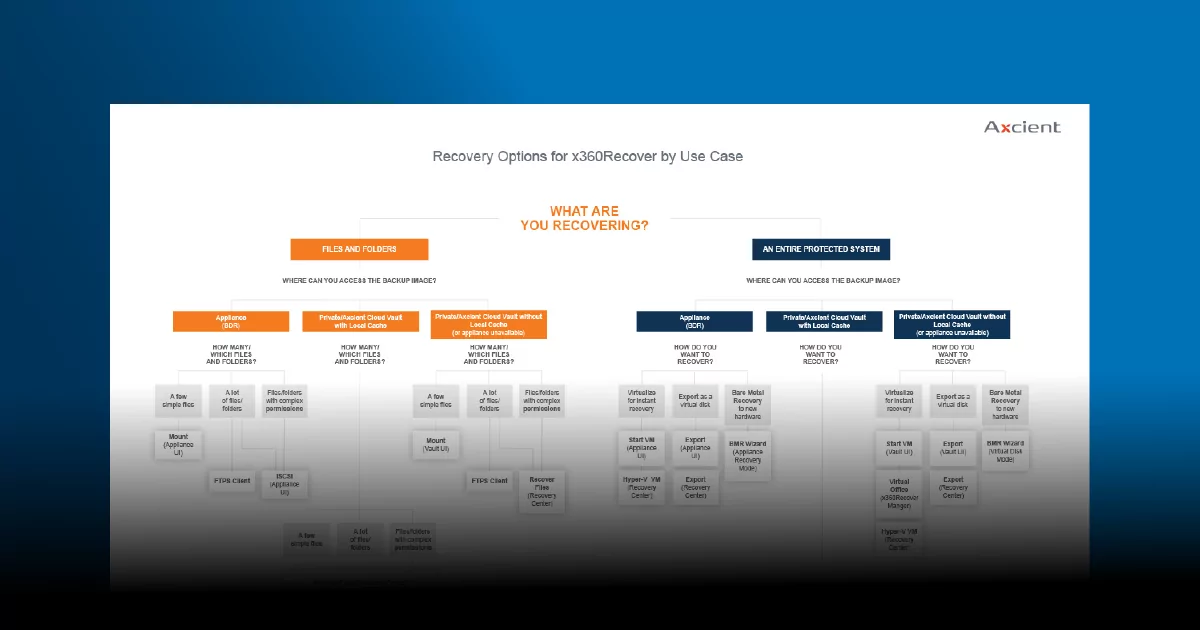
How Incremental BMR Accelerates System Restores for MSPs
Bare metal restore (BMR) has long been a reliable method for restoring entire systems from backups. However, traditional BMR has a major drawback: systems must be shut down during restoration, causing significant downtime. Axcient developed incremental BMR for x360Recover business continuity and disaster recovery (BCDR) to speed up processes and minimize business disruption for your clients. This article explores the differences between traditional BMR, incremental BMR, and differential backups, highlighting the key benefits for MSPs.
Table of Contents
BMR vs. Incremental BMR
Bare metal restore (BMR) involves recovering a complete system—including the operating system, applications, and data—onto new or repaired hardware. This process is essential for disaster recovery scenarios where hardware failure or ransomware attacks require full-system restoration. However, traditional BMR requires a complete restore of all data before the system can become operational again, leading to prolonged downtime.
The biggest limitation of traditional BMR is that it requires shutting down the protected system during restoration. The rigidity of the process causes two significant issues:
- Any changes made after the last backup are lost, leading to potential data gaps, data inconsistency, and data unreliability.
- The longer the restore takes, the longer the client experiences downtime, which is unacceptable for mission-critical systems, leading to client dissatisfaction and churn.
Incremental BMR is an enhancement that significantly improves the efficiency and effectiveness of disaster recovery. Instead of requiring a complete system restore in one operation, incremental BMR enables multiple restore passes. During each pass, only the changes made since the last backup are copied over. This means the majority of the restore process can occur while the original or failover system remains online.
Incremental BMR vs. Differential Backup Restores
While incremental BMR and differential backup restores share the goal of reducing downtime and improving recovery efficiency, they function differently. The goal of both methods is to minimize downtime for businesses by streamlining and simplifying both backup and recovery, allowing MSPs to manage data restores with more options compared to traditional BMR recovery methods.
While incremental BMR and differential backup restore goals are similar, there are key differences in execution and outcomes.
- Backup type: Incremental backups capture only changes since the last backup, whether it was a full or incremental. Differential backups capture all changes since the last full backup.
- Restore process: Incremental BMR can be conducted in multiple passes with the system remaining online. Restoring from a differential backup necessitates applying the latest complete backup along with the most recent differential backup.
- Downtime impact: Incremental BMR downtime is minimal because most of the data has already been restored, making the final cutover very quick. Differential backup restores have a higher potential for downtime due to the larger backups accumulating over time.
- Efficiency: Incremental BMR is more effective for long-running restore operations. Differential backup restores require more storage space as they increase in size.
- Flexibility: With incremental BMR, MSPs can maintain system operations throughout most of the restore process. Differential backup restorations require more storage, which means the size of the backups influences recovery speed.
Incremental BMR is a more efficient and flexible restoration solution for MSPs prioritizing minimal downtime. Because incremental BMR allows systems to remain online during recovery, clients experience significantly less disruption. In contrast, restoring from differential backup typically means longer restore times compared to incremental backups, especially when several differential backups exist. Differential backup requires applying larger data sets over time, which can increase restore times and storage requirements.
The Benefits of Incremental BMR for MSPs
Downtime equals lost revenue, disrupted workflows, and unhappy clients for all MSPs. With traditional BMR, the restoration process can be time-consuming and inefficient, making it difficult for MSPs to meet stringent service-level agreements (SLAs). Incremental BMR changes the game by enabling a more seamless recovery process so MSPs can…
- Reduce downtime: By eliminating the wait time required with traditional BMR, MSPs can recover critical business operations faster than before. By lowering the complexity required for recovery, MSPs inherently deliver more competitive BCDR services to clients, ensuring uninterrupted business continuity.
- Gain continuous protection: Backups run in the background while the restore process continues, preventing data loss and ensuring the latest changes are captured before the final restore cutover.
- Perform final cutover faster: Since the bulk of the data is restored incrementally, the final shutdown window is minimized, making the transition nearly seamless and reducing the impact on client workflows.
- Improve customer service and satisfaction: Faster restores and less downtime translate to improved SLAs and happier clients who can continue operations with minimal disruption, fostering long and positive relationships with your MSP.
- Increase efficiency: By streamlining the BMR process, MSPs can manage multiple restore tasks simultaneously without dedicating excessive resources to lengthy full-system restores.
How Incremental BMR for Axcient x360Recover Works
In four steps, MSPs can perform long-running restore operations efficiently while minimizing client disruption for faster recovery.
- Initial restore pass: The first restore operation copies most system data to the recovery hardware.
- Incremental updates: The system remains online while additional restore passes copy only the changes made since the last restore.
- Final synchronization: When ready, MSPs perform a final incremental update and then briefly shut down the system to complete the last data copy.
- System go-live: The recovered system is booted up with minimal downtime, ensuring business continuity.
Get Started with Incremental BMR Today
Incremental BMR is a game-changer for MSPs looking to optimize BCDR strategies with modern technology. By restoring systems in stages while keeping them online, MSPs can enhance their service offerings and cybersecurity reliability. Axcient’s x360Recover with incremental BMR empowers MSPs to take a more innovative, resilient, and faster approach to disaster recovery. This feature allows MSPs to provide clients unparalleled data protection and business continuity. Leverage Axcient’s incremental BMR for x360Recover today!
Author
Related posts
How well could you sleep with reliable cloud-based backups and recovery?
Take a deep dive into Axcient’s proprietary, automated security features to see how we’re ensuring uninterrupted business continuity — no matter what:




